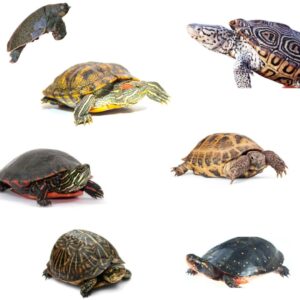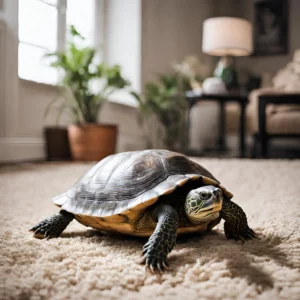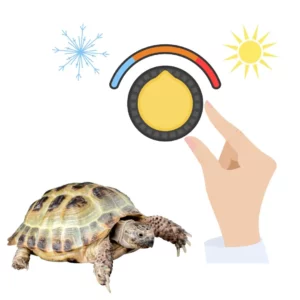Turtles are considered great low-maintenance pets. However, they still need care and attention.
Pet turtles may not require grooming or walks, but they need adequate:
- Habitat
- Water quality
- Lightning
- Humidity levels
- Diet
- Health checks
So, to help you choose the best turtle for beginners, we are going to list turtle types that are:
- Easy to take care of
- More independent
- Friendly
- Adorable
Let’s start.
Table of Contents
Beginner-Friendly Pet Turtle List
| Best Pet Turtles for Beginners |
| Painted Turtle (Eastern Painted turtle) |
| Musk Turtle (Common/Eastern Musk Turtle) |
| Map Turtle (Mississippi Map Turtle) |
| Slider Turtle (Red-eared Slider turtle) |
| Box Turtle (Eastern Box turtle) |
| Diamon-Back Terrapin Turtle |
Painted Turtle (Eastern Painted turtle) – Best Pet Turtle for Beginners
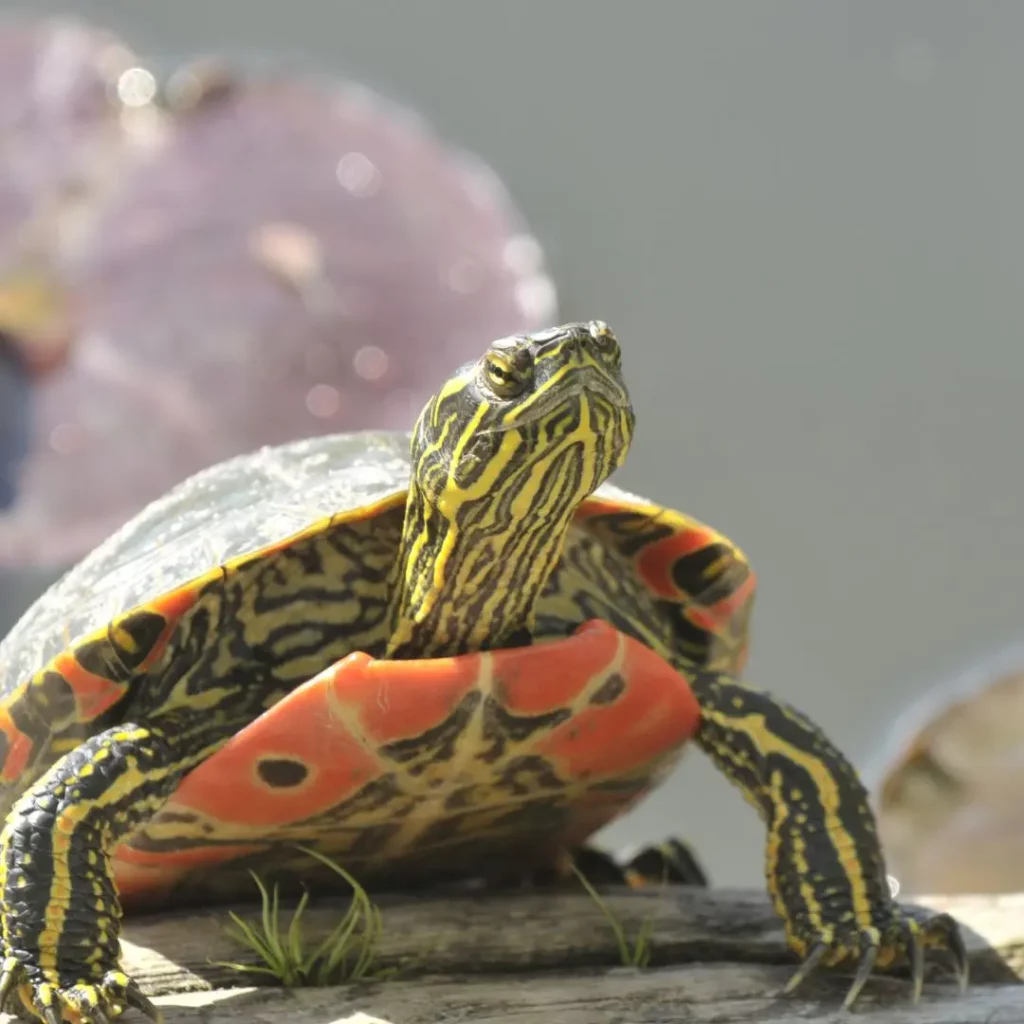
The Painted turtle is often the top choice for beginners, with the Eastern Painted being the most commonly domesticated and popular species.
In total, there are four distinct subspecies of painted turtle, including:
- Eastern
- Southern
- Midland
- Western
Here are some of the characteristics that make an Eastern Painted turtle the best option for a beginner turtle parent:
- Adaptable and Easy to Care For: Painted turtles are happy in various climates, making them suitable for most homes. They’re also low-maintenance turtles compared to most other species – if there is such a thing as a low-maintenance turtle 😅.
- Active and Entertaining: Don’t let their laid-back nature fool you. Painted turtles are curious explorers, always eager to check out their surroundings. Watching them navigate their tank, bask in the sunlight (or UVB lighting), or chase after a juicy worm is endlessly entertaining.
- Friendly and Tolerant: Unlike some turtles that prefer solitude, Painted turtles are quite social. They’re often okay sharing their space with another turtle buddy and generally tolerate gentle handling.
This makes them perfect for families with children who want to learn about animals and responsible pet ownership.
- Hardy and Long-Lived: Painted turtles are champions of resilience. They can live up to 40 years with proper care.
Note: Remember that each turtle has personal needs and preferences. So, when it comes to caring for your turtle, what works for one may not work for another.
A painted turtle is a charismatic reptile that’ll steal your heart with its stunning looks, affectionate and playful nature, and easy-going personality!
Appearance
The Eastern Painted turtle is easily recognizable due to its dark shell, featuring olive-colored lines that cover its upper shell, separating the shell scales. The edges of the upper and lower shells have distinctive black and red markings.
While the plastron is typically yellow, it may occasionally exhibit a red hue. Also, this turtle species’ head, neck, and limbs are decorated with vibrant yellow stripes.
Unlike most other pet animals, female Eastern Painted turtles tend to be larger in size than males. On average, females grow about six to seven inches (15.24 cm to 17.78 cm), while males are typically about five to six inches (12.7 cm to 15.24 cm).
Musk Turtle (Common/Eastern Musk Turtle)
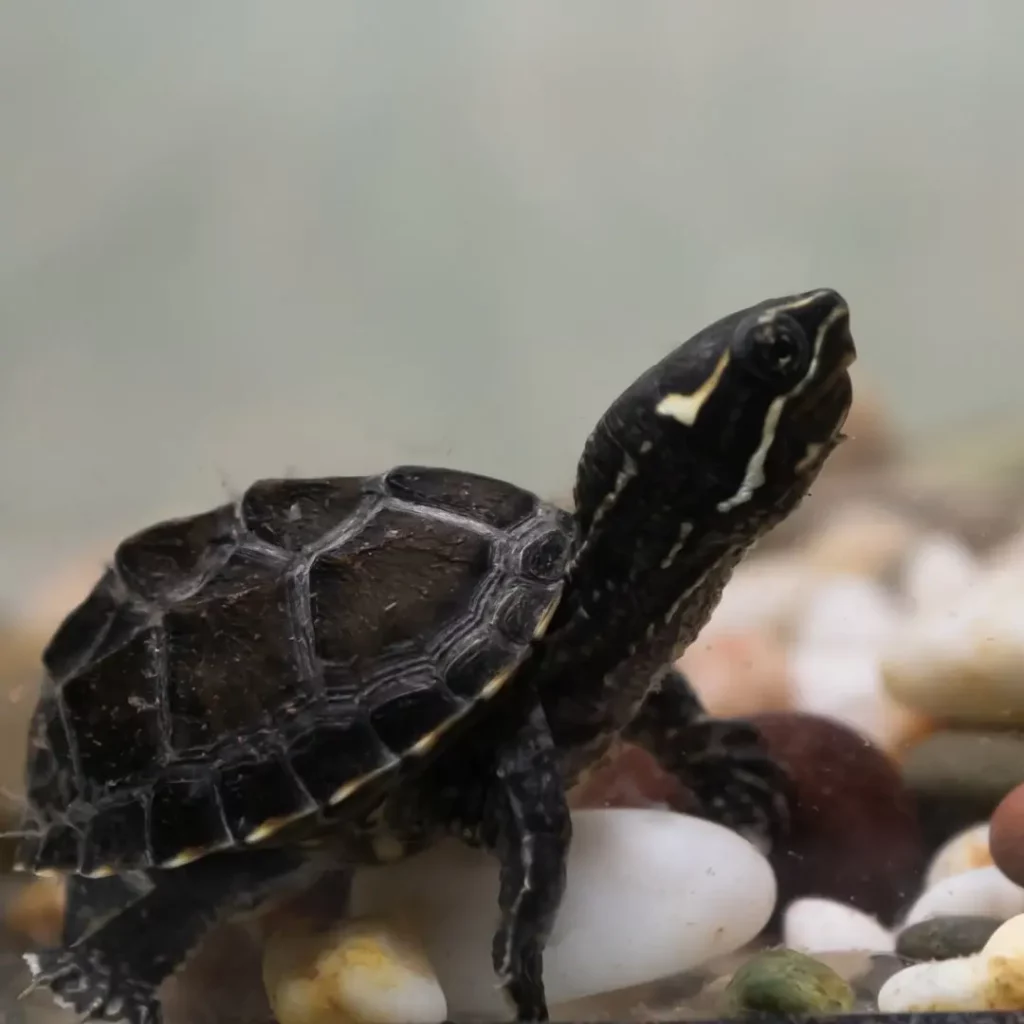
There are six different sub-species of Musk turtles, including:
- Common/Eastern
- Razor-Back
- Flattened-Back
- Loggerhead
- Intermediate
- Narrow-bridget
- Mexican musk turtle (Mexican Gient musk)
The Eastern Musk turtle, also known as the Common Musk turtle, is the most popular choice of Musk types.
A Musk turtle is mostly independent and has an easy-going character. Many turtle enthusiasts consider them to be the introverts of the turtle world. Unlike some turtles that crave constant attention, musks are perfectly content with solo time, making them ideal for beginners and busy owners.
They’re happy spending their days basking under a heat lamp, munching on aquatic insects and fish, and exploring the depths of their watery domain.
But what makes these little fellows unique is that they can release an unpleasant odor if they get scared or feel threatened, which is how they got their name – like a skunk 🦨💨.
Appearance
Musk turtles are among the smaller pet turtles – males and females are similar in size and tend to grow only about five inches (12.7 cm). Their shells are mostly brown or black and may be streaked or mottled. Also, they typically have two distinct stripes on the head.
Compared to other turtles, the shell of a Musk turtle accumulates green algae more often, especially as they age.
Their compact size means they don’t need a massive tank (20-gallon/75.7 l aquarium is usually plenty), making them ideal for smaller spaces.
Map Turtle (Mississippi Map turtle)
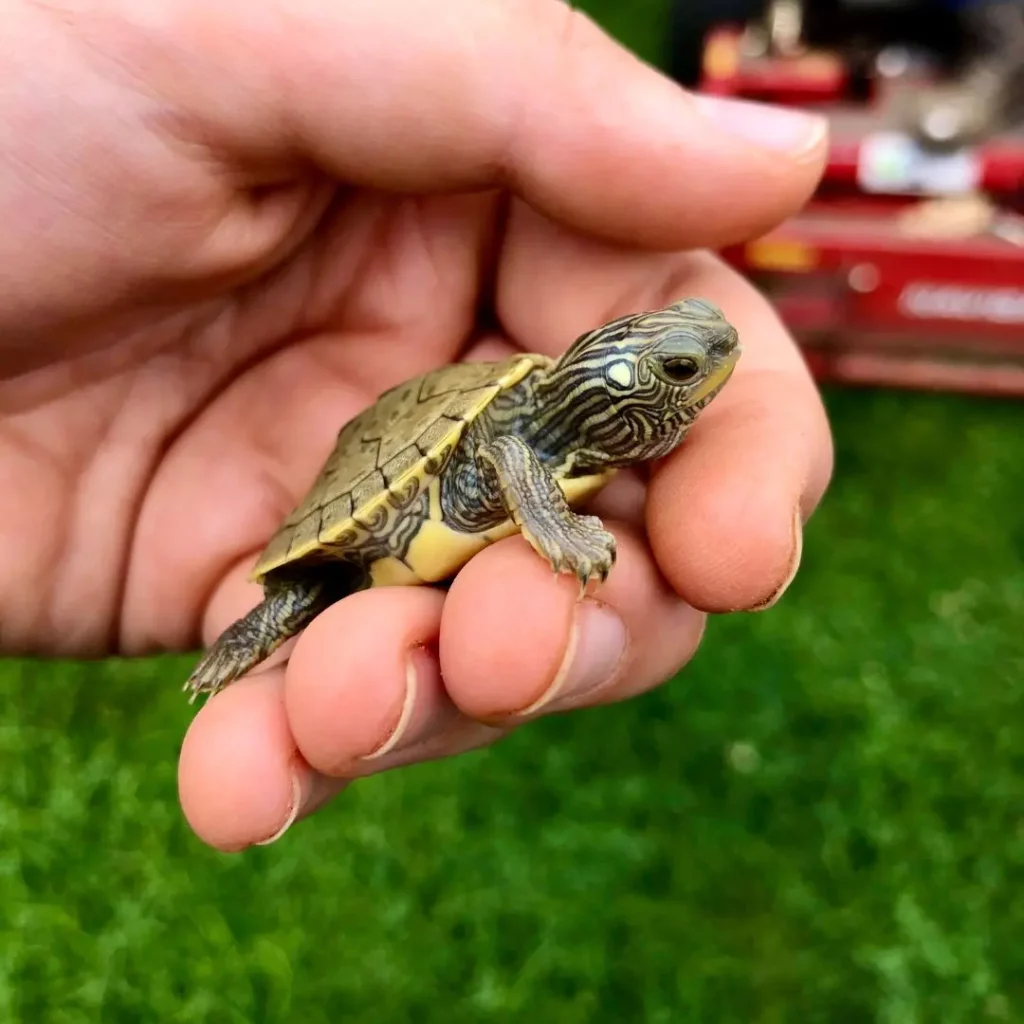
Map turtles are named after the patterns on their shells, which bear a striking resemblance to maps. There are 14 map turtles, but the most suitable and popular map turtle for a pet is the Mississippi Map turtle.
Although Mississippi turtles enjoy companionship, they tend to be a bit territorial as they get older – it’s best to keep them in a pair of different genders.
Considering their gentle and affectionate nature, they may be perfect for families with children or beginner parents who are often home and can spend enough time with their pets.
Appearance
The Mississippi Map turtle has a noticeable ridge that runs along the center of their shell, resembling a saw with serrated edges. It’s in shades of brown or olive and adorned with slender, interconnected yellow lines or circles.
On the other hand, the plastron, or lower shell, displays a light green-yellow hue with light brown lines resembling the grain of wood running along the seams of the scutes. As the turtle ages, these wood-like lines fade and become less prominent.
What sets the Mississippi map turtle apart from other map species is the presence of vibrant yellow reverse crescents that extend beneath and behind both of its eyes.
Female map turtles have larger bodies than their male counterparts, although their tails are smaller. On the other hand, male map turtles have slightly longer nails on both their forelegs and tails.
These tiny turtles are similar in appearance to Painted turtles but are more sensitive to their habitat’s water quality and hygiene level than Painted ones.
So be ready for extra cleaning and ensure you provide top-tier water filtration if you choose a Mississippi turtle.
Slider Turtle (Red-Eared Slider Turtle)
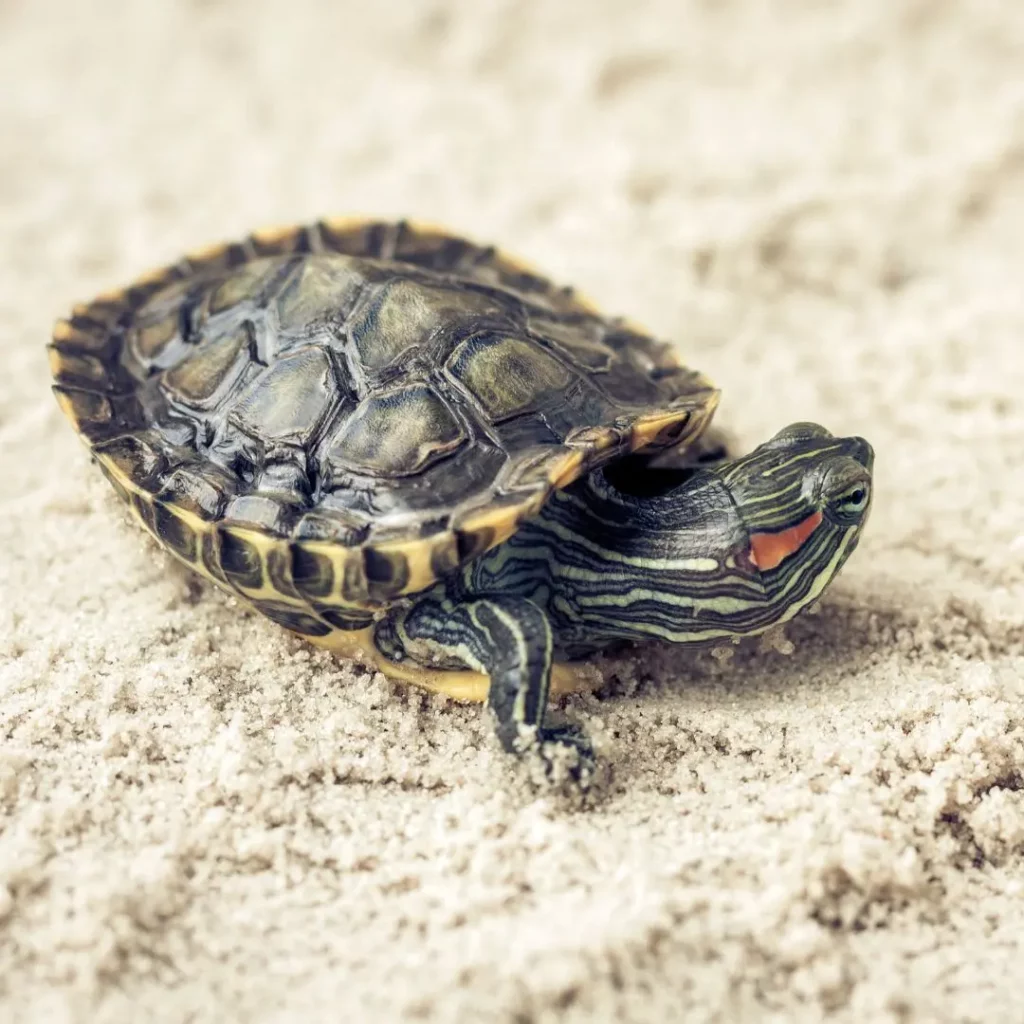
There are three distinctive sub-species of Sliders:
- Red-eared Slider
- Yellow-bellied Slider
- Cumberland Slider
Red-eared Slider turtle is the most common species in the wild, and they’re also the most popular choice for pets, not just when it comes to Slider turtles but turtles in general.
However, despite their popularity, it’s important to note that they’re much larger than other pet turtles. Their size makes it more difficult to care for them because they need much more space.
They thrive in small ponds, but not everyone has a spacious yard to accommodate that. So, if you don’t have enough space or are not ready for constant changes in their tank/habitat, you may want to check other pet turtles from this list.
On the other hand, they don’t require a quite specific diet like Box turtles or water quality like Mississippi turtles, making them one of the lower-maintenance pet turtles.
Appearance
The most distinctive feature of Red-eared Sliders is the red stripe on each side of their heads, for which they got their name.
A Red-eared Slider turtle’s upper shell (carapace) and skin display shades of olive to brown, adorned with yellow stripes. The lower shell (plastron) typically exhibits a yellow hue, although occasionally, it may appear as a brownish-orange shade.
Notably, each shell plate (scute) on the plastron features dark spots at its center.
Red-eared Sliders can vary in size, measuring five to 11 inches/12.7 to 27.9cm. But they’re often ten inches/25.4 cm or above.
The tails of males are thicker and longer than those of females, with a noticeably larger gap between the tail and the cloaca.
Box Turtle (Eastern Box Turtle)
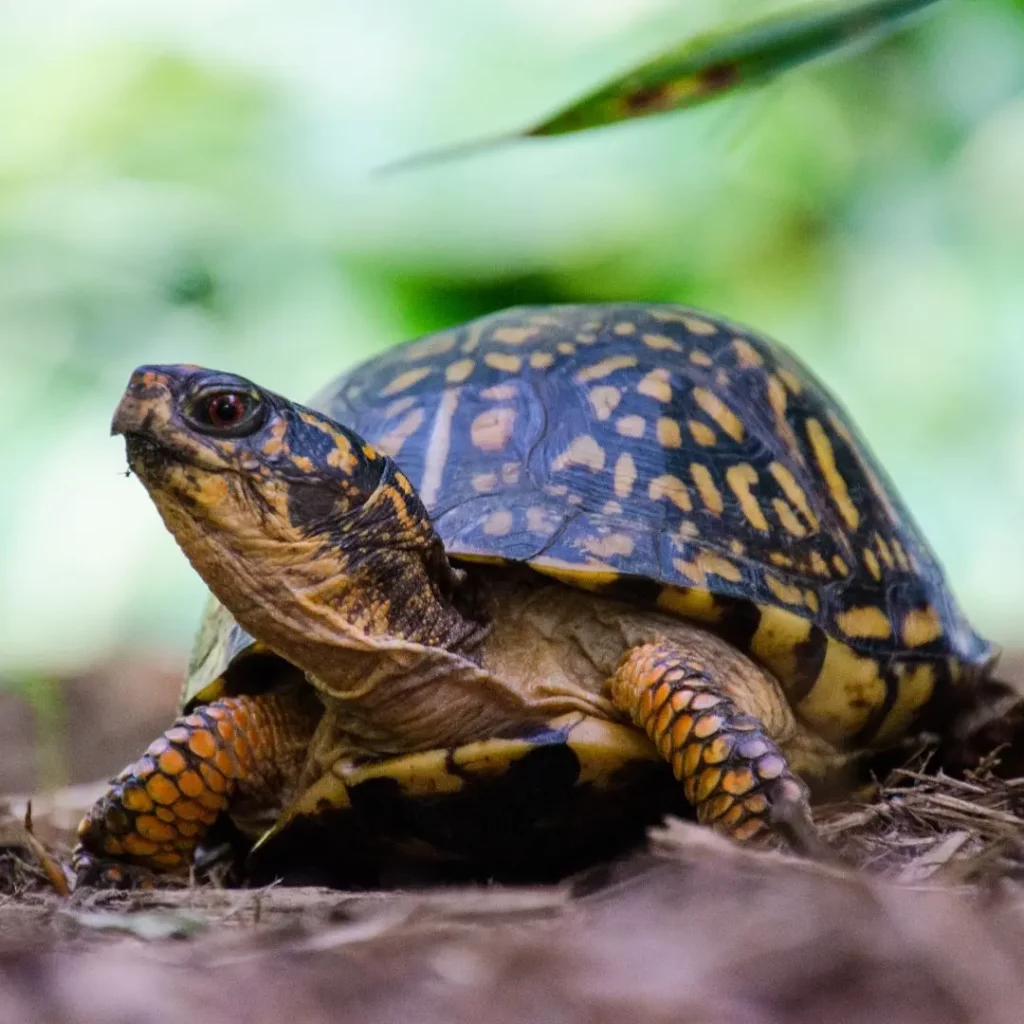
Box turtles are terrestrial species, and the two most common, popular pet sub-species are the Eastern Box turtle and the Three-Toed Box turtle. But the Eastern Box species is a more popular one.
An interesting behavior that makes an Eastern Box turtle unique is their defensive behavior. When they’re in danger or simply afraid, they can quickly and entirely hide inside their shells – like getting into a box, hence the name 📦🐢.
Box turtles primarily inhabit land in the wild, with occasional sightings near water areas like swamps or marshes. These water sources usually have shallow water and plenty of debris for them to climb onto.
This turtle species is great for beginner turtle owners because Eastern Box turtles are adaptable and thrive in simple setups – a tank or terrarium with a basking area, a cool, humid spot, and plenty of soil for burrowing is their happy place.
With an Eastern Box turtle, there’s no need to constantly change water or clean filters like with other species. Meaning you can even keep them outside during warm days, if you have a yard and are not surrounded by turtle’s potential predators (larger birds, raccoons, coyotes, etc)
That’s why it’s beneficial to include a small pond or tub of water for them to splash around in when creating an enclosure.
However, they have a diverse diet that includes protein from insects like grasshoppers, worms, caterpillars, and crickets. And besides minerals and vitamins from veggies and fruits, they also need plants.
Appearance
The Eastern Box turtle has a hard upper shell that’s high-domed and rounded in shape. Its dark brown shell is adorned with vibrant orange and yellow markings, setting it apart from other box turtles. Also, the presence of four toes on its hind feet is another of their distinguishing features.
They grow to about 4.5 to 8 inches (11.4 cm to 20.3 cm). Males and females are similar in size. While the female’s plastron is flat, it’s concave for males.
Diamond-Back Terrapin Turtle
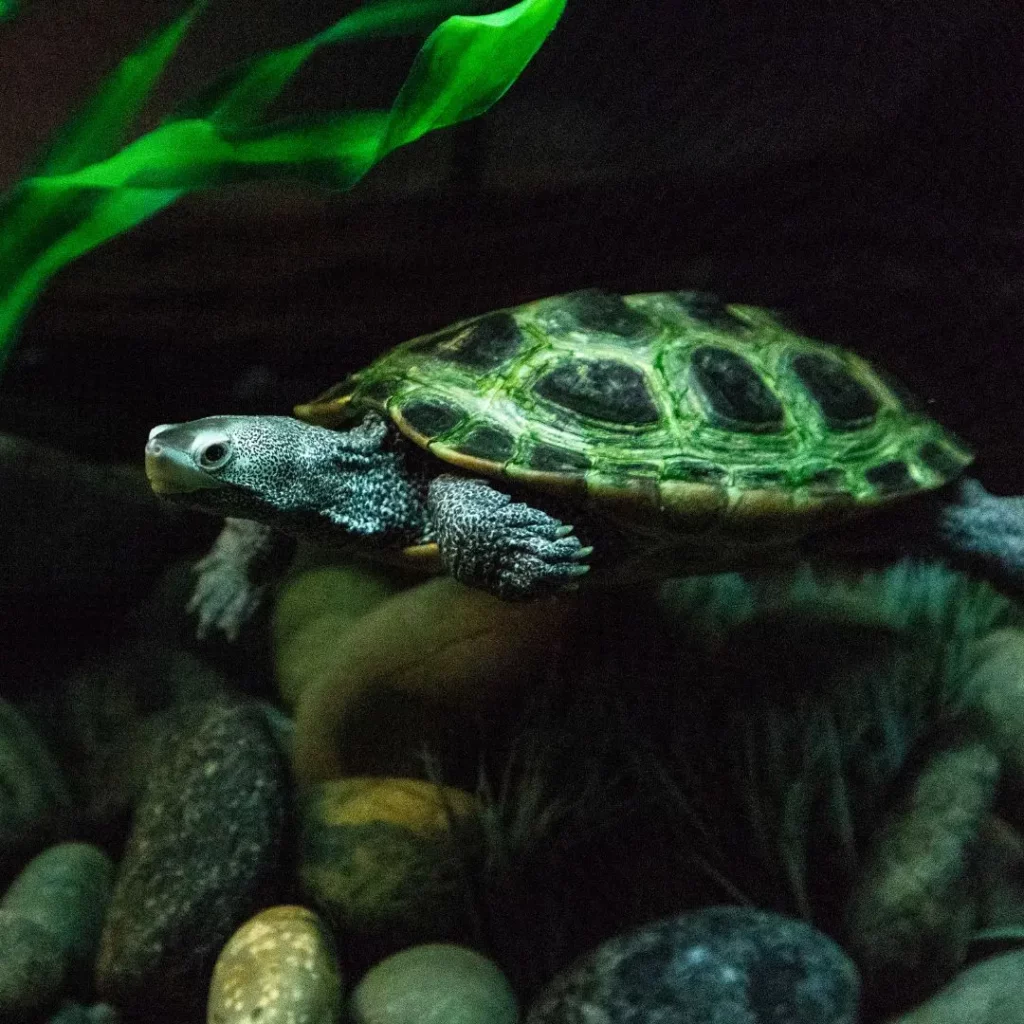
Diamond-back Terrapins have a bit more specific needs when it comes to their living conditions and taking care of them compared to other turtles on the list. This is simply because their natural habitats are brackish waters – water whose salinity is between fresh and marine water.
So, finding the proper water, keeping it clean, and maintaining an adequate temperature in the tank can be tricky. But don’t be discouraged – they’re highly adaptive and are not defensive or territorial species who enjoy companionship, making them another excellent choice for beginners.
Appearance
Measuring only five to seven inches/12.7 cm to 17.8 cm, these are another great example of compact turtle species that don’t require a large habitat – they’re perfectly comfortable in a moderately sized tank with land and water areas.
Diamondback terrapins are water-dwelling turtles with circular, diamond-patterned markings and ridges on the plates of their top shells, known as carapaces.
These shells can vary from medium gray or brown to almost black. Their skin can range from light gray to black and is often adorned with dark spots, patches, or stripes.
How to Choose a Beginner-Friendly Turtle?
Before you decide, it’s critical to understand that turtles make wonderful pets but require a long-term commitment. There are a lot of living conditions that can impact the quality of their life and determine how long turtles live.
To help you choose the right beginner-friendly turtle, here are some important factors you should consider:
Habitat Haven
- Space matters: Turtles need room to roam! Research your chosen species’ adult size and ensure their enclosure accommodates their needs. Think tanks or ponds, not shoeboxes.
- Aquatic or terrestrial? Some turtles are water lovers, others landlubbers, and some enjoy both. Choose a species that thrives in an environment you can comfortably provide.
- Sun seekers: Most turtles bask in warmth, so provide heat lamps and basking areas to keep them happy and healthy.
Dietary Delights
- Omnivore appetites: Most turtles are omnivores, enjoying a mix of plant and animal protein. Offer a variety of veggies, fruits, and insects to keep their taste buds tantalized and their bellies full. Read more on pet turtle nutrition.
- Freshness first: Always provide clean water and fresh food. Leftovers are a no-go in turtle town!
- Vitamin boost: Some species need vitamin and mineral supplements to stay healthy. Consult your vet for the right regimen.
Lifelong Companions
- Decades of devotion: Turtles aren’t just temporary roommates; they can live for decades! Be prepared for a long-term commitment.
- Generational guardians: Consider adopting! Shelters often have turtles needing loving homes, and you’ll give a deserving reptile a second chance.
- Growing needs: As your turtle ages, their needs may change. Be flexible and adjust their habitat and care accordingly.
Water Worries
- The quality: The water quality in your turtle’s enclosure is mandatory. Use filters and perform regular water changes to keep it clean and healthy. Think sparkling swimming pools, not murky swamps! Well, unless we’re talking box turtles.
- The right type: Some turtles prefer freshwater, others brackish (a mix of salt and fresh), and some even handle saltwater. Match your turtle’s needs for optimal health.
Maintenance Matters
- Regular cleaning: Turtle enclosures require regular cleaning to remove waste and prevent the buildup of harmful bacteria. Think of it as keeping your own personal Jurassic Park sparkling.
- Health checks: Schedule regular vet visits to ensure your turtle’s well-being.
Remember: By carefully considering these factors, you can ensure you and your new shelled companion embark on a happy and healthy adventure together.
My Senior Paws is a participant in the Amazon Services LLC Associates Program, an affiliate advertising program designed to provide a means for sites to earn advertising fees by advertising and linking to Amazon.com. We also participate in other affiliate programs which compensate us for referring traffic.

